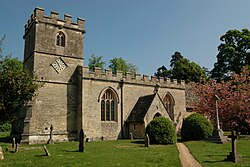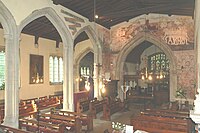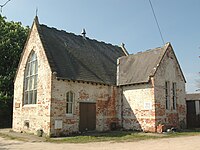South Leigh
| South Leigh | |
| Oxfordshire | |
|---|---|
 St. James the Great, South Leigh | |
| Location | |
| Grid reference: | SP392088 |
| Location: | 51°46’37"N, 1°25’59"W |
| Data | |
| Population: | 336 (2011) |
| Post town: | Witney |
| Postcode: | OX29 |
| Dialling code: | 01993 |
| Local Government | |
| Council: | West Oxfordshire |
| Parliamentary constituency: |
Witney |
| Website: | www.southleigh.info |
South Leigh is a village on Limb Brook, a small tributary of the River Thames, about two and a half miles east of Witney in Oxfordshire. The 2011 Census recorded the parish's population as 336.
Contents
History
South Leigh was not mentioned in the Domesday Book of 1086, but was recorded in 1190 as Stanton Lega.[1] The manor house was built in the second half of the 16th century. It is now called Church Farm House. In the middle of the 17th century William Gore acquired the manor, and the Gores consolidated South Leigh as a separate estate within Stanton Harcourt parish. When Stanton Harcourt's common lands were being enclosed in 1773, its enclosure commissioners suggested promoting a single Parliamentary bill to enclose both estates.[1] Edward Gore and his tenants in South Leigh disagreed due to the unresolved boundary disputes and consequent disagreement over what lands would be allotted to whom under the enclosure award.[1] Instead Stanton Harcourt's enclosure commissioners were empowered to settle a definitive boundary between the two estates.[1]
At some time after 1773 the Gores sold South Leigh estate to John Sibthorp. In 1792, a generation after Stanton Harcourt's enclosure, two thirds of South Leigh's land remained unenclosed.[1] Sibthorp obtained an Act of Parliament that led to their enclosure in 1793.[1] About 1,663 acres were enclosed, of which the commissioners awarded 1,233 acres to Sibthorp.[1] South Leigh had coppices of pollarded elms to supply wood for various purposes. Between 1793 and 1795 Sibthorp had more than 3,000 trees around the estate, most of them pollarded elms, felled to make fences for the new enclosures.[1] The Sibthorps felled large timber trees as well as wood, and early in the 19th century there were two major auctions of ash, elm and oak.[1] Sibthorp wrote that in the first ten months after the enclosure award:
I have worked up between 2000 and 3000 trees to posts and rails for my enclosure, besides a great quantity of timber used in the general repair of the farmhouses and cottage. I have quicked near upon 100 furlongs and fenced with posts and rails one-half of it. Gates and gateposts on the enclosures. I had three teams of horses constantly employed during the summer, yet unequal to my work.[2]
The Witney Railway was built through the parish and opened in 1861. South Leigh railway station served the parish until 1962, when British Railways withdrew passenger services from the line, and closed the line to freight traffic in 1970 and the track was dismantled some time thereafter.
Church and chapel
Church of England
The Church of England parish church, St James the Great began as a chapel of the parish of Stanton Harcourt, and remained so until 1868.[3] The oldest parts of the church building date from the latter part of the 12th century. The present chancel arch was built about 1300, the tower arch was built during the 14th century and the south doorway of the nave dates from about 1400. The church building was extensively altered in the 15th century: the north aisle and chapel were added, the bell tower was completed, and new windows were inserted in the south and east walls of the chancel.[3]
In 1871–72 the architect Ewan Christian restored the chancel and Clapton Crabb Rolfe began restoring the nave. Rolfe's cousin Harry Wilkinson Moore completed the nave restoration in 1887–88.[4] During the restoration extensive 15th century wall paintings were discovered.[3] They include a Doom painting over the chancel arch,[5][6] the seven deadly sins,[7] St Michael weighing souls,[8] the Virgin Mary (originally part of an Annunciation scene) and a rare painting of St Clement.[9] Burlison and Grylls heavily restored the paintings, re-drawing the weighing of souls at twice its original size.[3]
St. James' tower has a ring of eight bells, all of which were cast by Mears & Stainbank of the Whitechapel Bell Foundry in 1907.[10]
Methodist
John Wesley preached in South Leigh in 1771. A small Methodist congregation was established in the village by 1817, and met in private houses until it had its own chapel built in 1876. By 1968 the chapel was used for worship only once a month, and in 1969 it was sold. It is now a private house.[11]
Outside links
| ("Wikimedia Commons" has material about South Leigh) |
References
- ↑ 1.0 1.1 1.2 1.3 1.4 1.5 1.6 1.7 1.8 Crossley and Elrington (1990) pp 238–244
- ↑ Emery 1974, p. 143.
- ↑ 3.0 3.1 3.2 3.3 Crossley & Elrington 1990, pp. 249–252
- ↑ Sherwood & Pevsner 1974, p. 769.
- ↑ Marshall, Anne (2000). "The Doom, South Leigh, Oxfordshire". Mediæval Wall Painting in the English Parish Church. http://www.paintedchurch.org/sthleigh.htm.
- ↑ Marshall, Anne (2000). "The Doom at South Leigh, details, Heaven and Hell". Mediæval Wall Painting in the English Parish Church. http://www.paintedchurch.org/sthleig2.htm.
- ↑ Marshall, Anne (2000). "South Leigh, Oxfordshire: The Seven Deadly Sins". Mediæval Wall Painting in the English Parish Church. http://www.paintedchurch.org/sleig7ds.htm.
- ↑ Marshall, Anne (2000). "St. Michael Weighing Souls, South Leigh, Oxfordshire". Mediæval Wall Painting in the English Parish Church. http://www.paintedchurch.org/sleigmic.htm.
- ↑ Marshall, Anne (2004). "St. Clement: South Leigh, Oxfordshire". Mediæval Wall Painting in the English Parish Church. http://www.paintedchurch.org/sleiclem.htm.
- ↑ Peter, Davies (14 December 2006). "S Leigh S James Gt". Dove's Guide for Church Bell Ringers. Central Council of Church Bell Ringers. http://dove.cccbr.org.uk/detail.php?searchString=south+leigh&numPerPage=10&Submit=++Go++&searchAmount=%3D&searchMetric=cwt&sortBy=Place&sortDir=Asc&DoveID=SOUTH+LEIG.
- ↑ "South Leigh". Oxfordshire Churches & Chapels. Brian Curtis. http://www.oxfordshirechurches.info/SouthLeigh.htm.
- Broome, Phyllis (1997, 1998) South Leigh Remembered, Broome
- Bruce, M.R. (1972). "An Oxfordshire enclosure 1791–94". Top. Oxon. 18.
- A History of the County of Oxford - Volume 12 pp 238-253: @ (Victoria County History)
- Long, E.T. (1972). "Mediæval Wall Paintings in Oxfordshire Churches". Oxoniensia (Oxfordshire Architectural and Historical Society) XXXVII: 86–108. SSN 0308-5562. http://oxoniensia.org/volumes/1972/long.pdf.
- Nikolaus Pevsner: The Buildings of England: Oxfordshire, 1974 Penguin Books ISBN 978-0-300-09639-2
- Thomas, D N: 'Dylan Remembered 1935-1953', vol. 2 pp124–139, Seren (2004)


